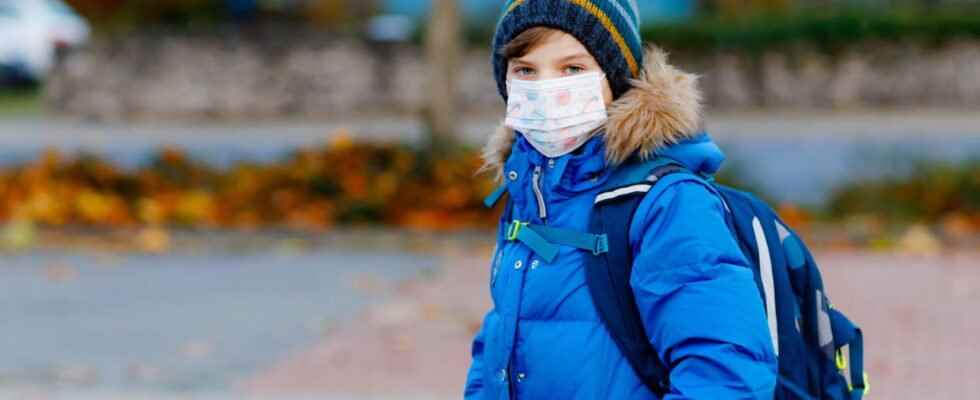Since January 3, new isolation and quarantine rules have applied depending on the pupil’s vaccination schedule. How many days must a child self-isolate before returning to school? What if my child has contact or has symptoms at school? We take stock.
What are the new isolation rules at school?
[Mise à jour du 5 janvier à 10h40]. Following the opinion of the High Council for Public Health, new isolation and quarantine rules apply from January 3, 2022.
► At school, positive students under 12 as well as older children with full vaccination status, isolation is 7 days. It can end after 5 days following a negative antigen or PCR test. If they are in contact, they do not need to isolate themselves but must perform a PCR or antigen test immediately then self-tests on D2 and D4. Note that when performing the first test in a pharmacy, parents receive the two self-tests free of charge on the second and fourth day. If the first test is carried out in the laboratory, parents will receive a voucher allowing them to collect the self-tests free of charge at the pharmacy.
► For positive students over 12 years of age as well as unvaccinated staff or without a complete vaccination schedule, the isolation period is then 10 days, or 7 days following a negative antigen or PCR test. If they are in contact, the isolation period is 7 days. “The isolation ends at the end of 7 days if an antigen test or PCR is carried out and the result is negative” specifies the Ministry of National Education.
► No class closure from 3 confirmed cases. In primary school, only pupils who can prove that they have had a negative test or self-test every two days are admitted to school. Therefore, “there is no longer any need to automatically close the class if three positive cases are identified”. The ministry nevertheless specifies that according to the situation, and because of a large number of cases, the reception of all the pupils of a class, a school or an educational establishment could be suspended.
Confirmed cases at school: what happens to students who are positive for Covid?
The student or staff positive for Covid must not go to school or establishment before a
help 5 to 10 days. Isolation can be lifted at 7 days or at 5 days depending on the case with a negative antigen or PCR test result and in the absence of clinical signs of infection for 48 hours: from the onset of symptoms for symptomatic cases, or from the positive sample for asymptomatic cases. In the event of fever on the 5th day, this period is extended until 48 hours after its disappearance.
- The isolation period is 7 days for students under 12 or over 12 as well as staff with full vaccination status. Isolation can be shortened to 5 days following a negative antigen or PCR test.
- The isolation period is 10 days (or 7 days following a negative PCR or antigen test) for people over 12 years old and unvaccinated staff, as well as those who do not have a complete vaccination schedule.
- The isolation period is 7 days for staff or students with contact cases at school over 12 years old who have not been vaccinated or without a complete vaccination schedule. Isolation ends at the end of these 7 days after a negative antigen or PCR test.
- Pupils under 12 (regardless of their vaccination status), those over 12 and staff with full vaccination status do not need to isolate themselves provided that an antigen or PCR test is carried out immediately after the occurrence of a positive case at school, and that the result is negative.
If a student tests positive for Covid in a nursery or elementary school, he will be immediately isolated from the rest of the class. The other pupils will then be screened and the reception of pupils is suspended pending the results of the tests. To continue the face-to-face learning, the students will have to present a negative antigen or PCR test, and the parents will have to attest on their honor to the realization of two negative self-tests on D2 and D4 from the first test. If the test is positive, the student therefore becomes a confirmed case and will have to isolate himself for 7 days or 5 days. If the test is negative, the student can return to school and attend extracurricular activities.
“In the absence of presentation of an antigen test or PCR for students in the class and other students who are at risk outside the classroom, the suspension of face-to-face reception is maintained for a period of 7 days which can be reduced to 5 days upon presentation of an antigen test or PCR negative and during which the pupils concerned benefit from distance learning. The information communicated by the school constitutes proof of the suspension of the reception.“specifies the Ministry of National Education.
As for adults, the duration of isolation differs according to the vaccination schedule for pupils aged 12 and over. Thus, the student must respect a 7-day quarantine after the last contact with the confirmed case and test immediately, then at the end of the 7 day period from the last contact with the confirmed case unless he is under 12 years old or if he can justify a complete vaccination schedule (two doses for 12-17 years old). Immediate screening should be performed (antigen test or PCR) and self-tests should be performed on D2 and D4. If the college or high school student is negative, he can continue face-to-face lessons while strictly respecting barrier gestures.
To be able to return to class, the parents will have to certify on their honor, from the first day, that the child has performed a negative test. In the absence of this certificate, the quarantine will be extended until it is produced or failing that up to 14 days.
days.
